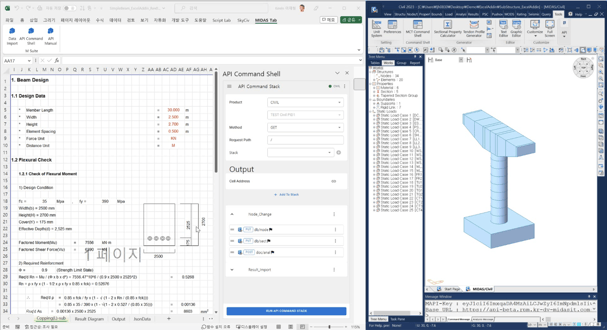Midas API: The Sky Is the Limit

Author: MIDASoft
Publish Date: 26 Dec, 2023
|
Summary: The rapidly evolving construction industry demands cutting-edge technology to ease engineers' efforts. This blog explores how Midas APIs address current engineering challenges and integrate seamlessly into a structural engineer's workflow. |
What is an Application Programming Interface (API)?
As engineers, we often wonder how engineers in the past have pulled off some marvelous structures like the Manhattan Bridge in New York without any structural software, let alone without any drafting tools like AutoCAD. Our future generations would wonder, just like we did, how we pulled off a few intricate designs without an Application Program Interface. I know all of you are excited to know more about API. Read on.
Currently, we have lots of structural analysis software available in the market. However, the users can't interact with the back end of the application and get the desired outputs.
The first thought that will come into your mind is exactly what this API is and why civil engineers need to know about this techno-sounding topic. Application Program Interface acts as a bridge and enables the users to talk to the backend of the software and bend the software to accommodate their workflow.
API helps connect different applications. What it means to engineers like us is with the help of this API, we can create Midas CIM models directly by specifying dimensions in Excel, analyze them in Midas Civil, take drawings from Midas Drafter and in the end, compile the Report in Excel, in just a couple of clicks.
Fig 1. Synergy beyond Midas with API.
Having an API allows engineers to create templates that integrate with their workflow. These features will help reduce civil and structural engineers' time and effort in designing similar structures and utilizing pre-designed models built with 3D modeling software (which offers API) with Midas structural analysis software. Significantly, post-processing, such as calling the result tables or taking analyzed result diagrams, will reduce repeating the work process and help make a better decision.
API - Current major difficulties faced by engineers
Before rushing to the usual next step, why do we need API? We were comfortable without the API, so why is this so important now? To know this, we need to know the current stage of the construction industry.
As we all know, structural consultants use various software for different purposes. The construction industry is also highly fragmented, leading to inefficiency. Each part of the construction process is handled by different firms using corresponding software solutions that have minimal to zero interoperability with each other. For example, design firms typically use Excel sheets for the load calculations, Midas Civil or any other analysis application for the analysis, and a CAD package like Midas CAD for drawing generation. The construction firm then uses these drawings to manufacture the segments. Each of the processes is interdependent on the other. A change in one requires everything to be redone or reworked. Thus, most of the time is spent on reworking. Advances are already being made with the deployment of BIM.
Once the work is done, report generation as per the DOT specifications again takes up another chunk of the engineer’s time since it is impossible for any software to include the report format for each client.
Summing up, there are three main problems engineers need help with the most.
- Lack of interoperability between software solutions
- Report generation
- Repetitive work
The introduction of API in the process can quickly solve these problems.
Midas API Integration in your Workflow
We are now coming to where Midas API fits in our workflow and why engineers call this technology the future.
Let’s start with a simple case scenario. We have a bridge, created all the models, and finally, the drawings and report. But, at the last minute, a change was made in the section. This slight modification requires changing the alignment of the analytical model. We must reanalyze the model and create a report out of this. Such a scenario is common in all design firms.
Fig 2. Linking Design sheet, Analytical, and BIM model through API
One of the main advantages of implementing an API is the ability to build a repository of templates.
The process of constructing a bridge starts with the Planning stage. At this stage, the client is sometimes unsure which type of bridge, and the alignment required. Quick bridge modeling can be done using the templates and API without starting from zero. This helps in determining the initial quantity and cost estimation.
In the Design phase, the design firm takes the DPR submitted and starts designing the section, span length and other parameters. This is then submitted to an external consultant for proof-checking. A lot of revision is required and done at this stage. Sometimes, the site constraints also call for edits in the model. For example, after drilling for one of the piles, a utility line is encountered which cannot be moved. Then, the pile needs to be relocated. Thus, a new model is required with updated piles. Implementing API reduces the effort required for the revisions drastically. Even the alignment of the bridge can be changed at any stage.
A report is also created in each revision. The usual workflow is to copy and paste data from analysis software into an Excel report. The required images are also attached similarly. Engineers in design firms take a lot of time creating 2D deliverables for their projects, which can be huge if the project they are working on is enormous.
Think about automating the whole process and generating the deliverables with a single click using the API
Fig 3. Seamless Interface for Working Flow
By utilizing APIs, we can increase productivity in several ways. For example, we can automate the process of updating your construction information modeling (CIM) models. This allows us to update and improve your model on the fly, so there are no delays or wait times for others to see the changes. Other productivity boosters include real-time scheduling and resource management.
Midas API: Simplifying Engineers' Lives
Visual learning is the easiest way to learn something new. Below are a few of the use cases of API, but with slight modifications, they can be adapted to any workflow requirements.
We will start with a simple implementation of API. This example creates a simply supported beam from a template in an Excel sheet.
The whole video can be summarized in three steps:
- Span length, loading, material, and section properties definition. With a single click, model files are generated in Midas Civil NX.
- Analysis can be executed directly by clicking an Excel button without going to Midas Civil NX.
- Finally, Results can be imported with a click. Results can include text, tabular, and image data.
Midas API: Cross-application interaction
API is not just limited to using an Excel template. Grasshopper, which aids engineers with the parametric modeling of complex structures, can be connected directly to Midas Civil NX using a simple Python API interface.
Midas API: Automatic Model, Drawing, and Report generation
Engineers can create analytical models using Excel sheets with structure and loading data. Using the same approach, a single Excel sheet can be linked to Midas Civil NX and Midas CIM, simultaneously generating the analytical and 3D models.
An existing template of the FSM Single Cell Box bridge is shown in the example. The Excel file contains information for generating an analysis model and BIM modeling using Midas CIM.
Midas API: Optimization
As the title suggests, the sky is your limit with API. It allows for separating and grouping different data sets to create sequential operations. Specific items can be set to run based on certain conditions in Excel. For example, you can continuously perform analysis by adjusting the value of a particular cell until N.G. changes to O.K. The results can also be automatically updated and refreshed after completing the analysis.
One such application is the pier section optimization. Rather than changing the sections each time and reanalyzing the model, we can use a loop and set the criteria of the PM interaction curve such that the section sizes will be reduced, and the analysis will run automatically until the column fails.
Fig 4. Midas API
Sealing the Deal: Why Midas API is Your Gateway to Success
Just as engineers heavily depend on software in the modern era, which has become an integral part of our daily lives, API is poised to play a crucial role in the future of structural engineering, inevitably becoming an essential component of our daily routines. APIs are a powerful tool that will help automate processes and streamline workflows. With that said, implementing an API can be complicated and requires some technical knowledge. With the Midas API, users can create models directly from design sheets.
The world is moving fast with complex bridge geometry, where people are obsessed with aesthetics. Parametric modeling using APIs reduces the modeling time to one-tenth, where this time is taken only for creating the code using any desired platform.
The construction industry has progressed from paper documents to digital workflows. Most of the Department of Transportation of various states in the United States have started making deliverables in 3D format mandatory, and engineers are forced to model the same bridge twice, which is time-consuming and hectic. With the interoperability of Midas Civil NX, Midas CIM, and Drafter, 3D models along with updated drawings can be generated in the desired format with a single click. Stay tuned for more Midas API updates.







Add a Comment